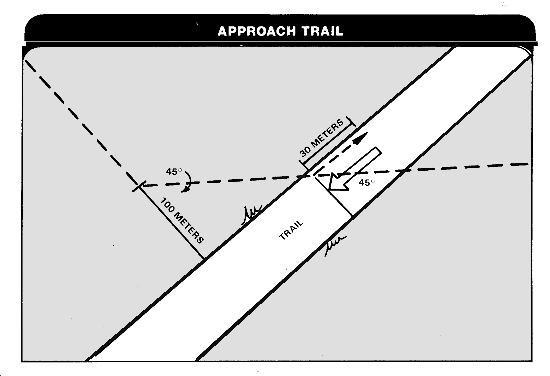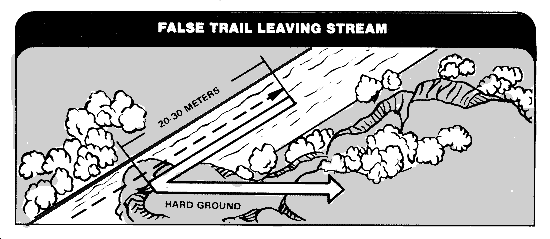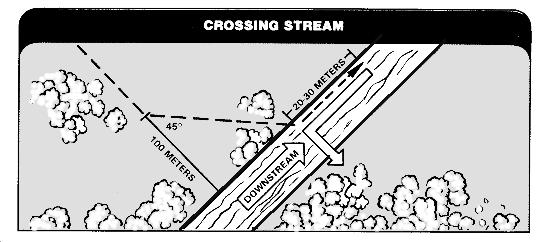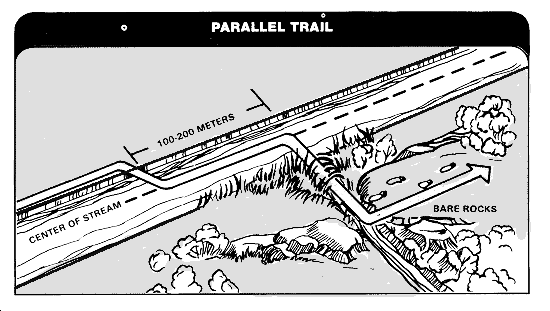In all operations, you must be alert for signs of enemy activity. Such signs
can often alert you to an enemy's presence and give your unit time to prepare
for contact. The ability to track an enemy after he has broken contact also
helps you regain contact with him.
Visual tracking is following the path of men or animals by the signs they
leave, primarily on the ground or vegetation. Scent tracking is following men or
animals by their smell.
Tracking is a precise art. You need a lot of practice to achieve and keep a
high level of tracking skill. You should be familiar with the general techniques
of tracking to enable you to detect the presence of a hidden enemy and to follow
him, to find and avoid mines or booby traps, and to give early warning of
ambush.
With common sense and a degree of experience, you can track another person.
However, you must develop the following traits and qualities:
When tracking an enemy, you should build a picture of him in your mind. Ask
yourself such questions as: How many persons am I following? How well are they
trained? How are they equipped? Are they healthy? How is their morale? Do they
know they are being followed?
To find the answer to such questions, use all available signs. A sign can be
anything that shows you that a certain act took place at a particular place and
time. For instance, a footprint tells a tracker that at a certain time a person
walked on that spot.
The six fundamentals of tracking are:
-
Displacement.
-
Staining.
-
Weathering.
-
Littering.
-
Camouflaging.
-
Interpretation and/or immediate use intelligence.
Any sign that you find can be identified as one or more of the first five
fundamentals. In the sixth fundamental, you combine the first five and use all
of them to form a picture of the enemy.
DISPLACEMENT
Displacement takes place when something is moved from its original position.
An example is a footprint in soft, moist ground. The foot of the person that
left the print displaced the soil, leaving an indentation in the ground. By
studying the print, you can determine many facts. For example, a print that was
left by a barefoot person or a person with worn or frayed footgear indicates
that he may have poor equipment.
HOW TO ANALYZE FOOTPRINTS
Footprints show the following:
-
The direction and rate of movement of a party.
-
The number of persons in a party.
-
Whether or not heavy loads are carried.
-
The sex of the members of a party.
-
Whether the members of a party know they are being followed.
If the footprints are deep and the pace is long, the party is moving rapidly.
Very long strides and deep prints, with toe prints deeper than heel prints,
indicate that the party is running. If the prints are deep, short, and widely
spaced, with signs of scuffing or shuffling, a heavy load is probably being
carried by the person who left the prints.
You can also determine a person's sex by studying the size and position of
the footprints. Women generally tend to be pigeon-toed, while men usually walk
with their feet pointed straight ahead or slightly to the outside. Women's
prints are usually smaller than men's, and their strides are usually
shorter.
If a party knows that it is being followed, it may attempt to hide its
tracks. Persons walking backward have a short, irregular stride. The prints have
an unusually deep toe. The soil will be kicked in the direction of movement.
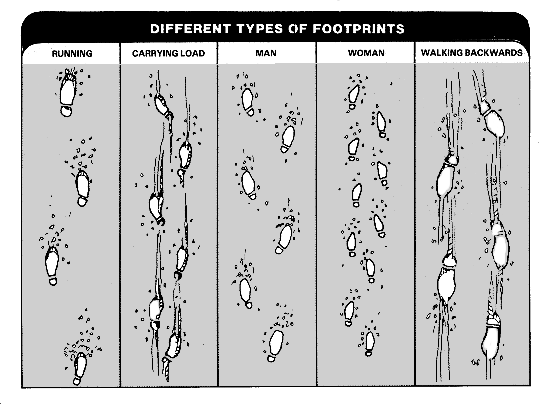
The last person walking in a group usually leaves the clearest footprints.
Therefore, use his prints as the key set. Cut a stick the length of each
key print and notch the stick to show the print width at the widest part of the
sole. Study the angle of the key prints to determine the direction of march.
Look for an identifying mark or feature on the prints, such as a worn or frayed
part of the footwear. If the trail becomes vague or obliterated, or if the trail
being followed merges with another, use the stick to help identify the key
prints. That will help you stay on the trail of the group being followed.
Use the box method to count the number of persons in the group. There are two
ways to use the box method--the stride as a unit of measure method and
the 36-inch box method.
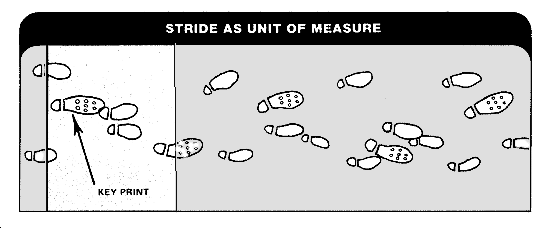
The stride as a unit of measure method is the most accurate of the two. Up to
18 persons can be counted using this method. Use it when the key prints can be
determined. To use this method, identify a key print on a trail and draw a line
from its heel across the trail. Then move forward to the key print of the
opposite foot and draw a line through its instep. This should form a box with
the edges of the trail forming two sides, and the drawn lines forming the other
two sides. Next, count every print or partial print inside the box to determine
the number of persons. Any person walking normally would have stepped in the box
at least one time. Count the key prints as one.
To use the 36-inch box method, mark off a 30-to 36-inch cross section of a
trail, count the prints in the box, then divide by two to determine the number
of persons that used the trail. (Your M16 rifle is 39 inches long and may be
used as a measuring device.)
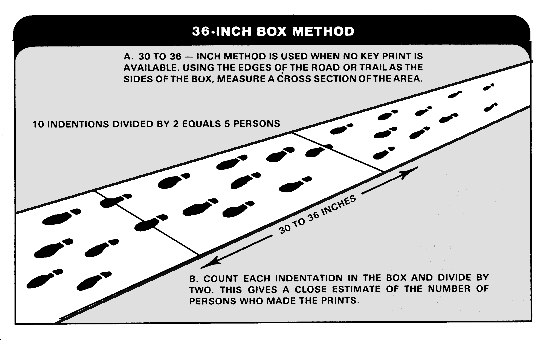
OTHER SIGNS OF DISPLACEMENT
Footprints are only one example of displacement. Displacement occurs when
anything is moved from its original position. Other examples are such things as
foliage, moss, vines, sticks, or rocks that are moved from their original
places; dew droplets brushed from leaves; stones and sticks that are turned over
and show a different color underneath; and grass or other vegetation that is
bent or broken in the direction of movement.
Bits of cloth may be torn from a uniform and left on thorns, snags, or the
ground, and dirt from boots may make marks on the ground.
Another example of displacement is the movement of wild animals and birds
that are flushed from their natural habitats. You may hear the cries of birds
that are excited by strange movements. The movement of tall grass or brush on a
windless day indicates that some thing is moving the vegetation from its
original position.
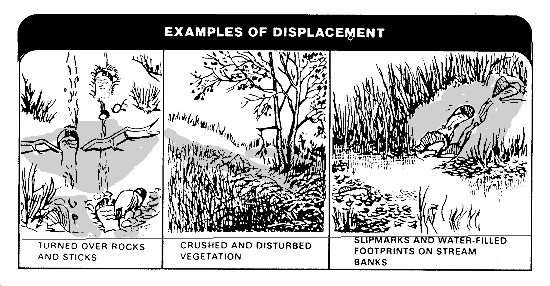
When you clear a trail by either breaking or cutting your way through heavy
vegetation, you displace the vegetation. Displacement signs can be made while
you stop to rest with heavy loads. The prints made by the equipment you carry
can help to identify its type. When loads are set down at a rest halt or
campsite, grass and twigs may be crushed. A sleeping man may also flatten the
vegetation.
In most areas, there will be insects. Any changes in the normal life of these
insects may be a sign that someone has recently passed through the area. Bees
that are stirred up, and holes that are covered by someone moving over them, or
spider webs that are torn down are good clues.
If a person uses a stream to cover his trail, algae and water plants may be
displaced in slippery footing or in places where he walks carelessly. Rocks may
be displaced from their original position, or turned over to show a lighter or
darker color on their opposite side. A person entering or leaving a stream may
create slide marks, wet banks, or footprints, or he may scuff bark off roots or
sticks. Normally, a person or animal will seek the path of least resistance.
Therefore, when you search a stream for exit signs, look for open places on the
banks or other places where it would be easy to leave the stream.
STAINING
A good example of staining is the mark left by blood from a bleeding wound.
Bloodstains often will be in the form of drops left by a wounded person. Blood
signs are found on the ground and smeared on leaves or twigs.
You can determine the location of a wound on a man being followed by studying
the bloodstains. If the blood seems to be dripping steadily, it probably came
from a wound on his trunk. A wound in the lungs will deposit bloodstains that
are pink, bubbly, frothy. A bloodstain deposited from a head wound will appear
heavy, wet, and slimy, like gelatin. Abdominal wounds often mix blood with
digestive juices so that the deposit will have an odor. The stains will be light
in color.
Staining can also occur when a person walks over grass, stones, and shrubs
with muddy boots. Thus, staining and displacement together may give evidence of
movement and indicate the direction taken. Crushed leaves may stain rocky ground
that is too hard for footprints.
Roots, stones, and vines may be stained by crushed leaves or berries when
walked on. Yellow stains in snow may be urine marks left by personnel in the
area.
In some cases, it may be hard to determine the difference between staining
and displacement. Both terms can be applied to some signs. For example, water
that has been muddied may indicate recent movement. The mud has been displaced
and it is staining the water. Stones in streams may be stained by mud from
boots. Algae can be displaced from stones in streams and can stain other stones
or bark.
Water in footprints in swampy ground may be muddy if the tracks are recent.
In time, however, the mud will settle and the water will clear. The clarity of
the water can be used to estimate the age of the prints. Normally, the mud will
clear in 1 hour. That will vary with terrain.
WEATHERING
Weather may either aid or hinder tracking. It affects signs in ways that help
determine how old they are, but wind, snow, rain, and sunlight can also
obliterate signs completely.
By studying the effects of weather on signs, you can determine the age of the
sign. For example, when bloodstains are fresh, they may be bright red. Air and
sunlight will change the appearance of blood first to a deep ruby-red color, and
then to a dark brown crust when the moisture evaporates. Scuff marks on trees or
bushes darken with time. Sap oozes from fresh cuts on trees but it hardens when
exposed to the air.
FOOTPRINTS
Footprints are greatly affected by weather. When a foot displaces soft, moist
soil to form a print, the moisture holds the edges of the print intact and
sharp. As sunlight and air dry the edges of the print, small particles that were
held in place by the moisture fall into the print, making the edges appear
rounded. Study this process carefully to estimate the age of a print. If
particles are just beginning to fall into a print, it is probably fresh. If the
edges of the print are dried and crusty, the prints are probably at least an
hour old. The effects of weather will vary with the terrain, so this information
is furnished as a guide only.
A light rain may round out the edges of a print. Try to remember when the
last rain occurred in order to put prints into a proper time frame. A heavy rain
may erase all signs.
Wind also affects prints. Besides drying out a print, the wind may blow
litter, sticks, or leaves into it. Try to remember the wind activity in order to
help determine the age of a print. For example, you may think, "It is calm now,
but the wind blew hard an hour ago. These prints have litter blown into them, so
they must be over an hour old." You must be sure, however, that the litter was
blown into the prints, and was not crushed into them when the prints were made.
Trails leaving streams may appear to be weathered by rain because of water
running into the footprints from wet clothing or equipment. This is particularly
true if a party leaves a stream in a file. From this formation, each person
drips water into the prints. A wet trail slowly fading into a dry trail
indicates that the trail is fresh.
WIND, SOUNDS, AND ODORS
Wind affects sounds and odors. If the wind is blowing from the direction of a
trail you are following, sounds and odors are carried to you. If the wind is
blowing in the same direction as the trail you are following, you must be
cautious as the wind will carry your sounds toward the enemy. To find the wind
direction, drop a handful of dry dirt or grass from shoulder height.
To help you decide where a sound is coming from, cup your hands behind your
ears and slowly turn. When the sound is loudest, you are probably facing the
origin of sound. When moving, try to keep the wind in your face.
SUN
You must also consider the effects of the sun. It is hard to look or aim
directly into the sun. If possible, keep the sun at your back.
LITTERING
Poorly trained units may leave trails of litter as they move. Gum or candy
wrappers, ration cans, cigarette butts, remains of fires, or human feces are
unmistakable signs of recent movement.
Weather affects litter. Rain may flatten or wash litter away, or turn paper
into pulp. Winds may blow litter away from its original location. Ration cans
exposed to weather will rust. They first rust at the exposed edge where they
were opened. Rust then moves in toward the center. Use your memory to determine
the age of litter. The last rain or strong wind can be the basis of a time
frame.
CAMOUFLAGE
If a party knows that you are tracking it, it will probably use camouflage to
conceal its movement and to slow and confuse you. Doing so, however, will slow
it down. Walking backward, brushing out trails, and moving over rocky ground or
through streams are examples of camouflage that can be used to confuse you.
The party may move on hard surfaced, frequently traveled roads or try to
merge with traveling civilians. Examine such routes with extreme care, because a
well-defined approach that leads to the enemy will probably be mined, ambushed,
or covered by snipers.
The party may try to avoid leaving a trail. Its members may wrap rags around
their boots, or wear soft-soled shoes to make the edges of their footprints
rounder and less distinct. The party may exit a stream in column or line to
reduce the chance of leaving a well-defined exit.
If the party walks backward to leave a confusing trail, the footprints will
be deepened at the toe, and the soil will be scuffed or dragged in the direction
of movement.
If a trail leads across rocky or hard ground, try to work around that ground
to pick up the exit trail. This process works in streams as well. On rocky
ground, moss or lichens growing on the stones could be displaced by even the
most careful evader. If you lose the trail, return to the last visible sign.
From there, head in the direction of the party's movement. Move in ever-widening
circles until you find some signs to follow.
INTERPRETATION/IMMEDIATE USE INTELLIGENCE
When reporting, do not report your interpretations as facts. Report that you
have seen signs of certain things, not that those things actually exist.
Report all information quickly. The term "immediate use intelligence"
includes information of the enemy that can be put to use at once to gain
surprise, to keep the enemy off balance, or to keep him from escaping an area. A
commander has many sources of intelligence. He puts the information from those
sources together to help determine where an enemy is, what he may be planning,
and where he may be going.
Information you report gives your leader definite information on which he can
act at once. For example, you may report that your leader is 30 minutes behind
an enemy unit, that the enemy is moving north, and that he is now at a certain
place. That gives your leader information on which he can act at once. He could
then have you keep on tracking and move another unit to attack the enemy. If a
trail is found that has signs of recent enemy activity, your leader can set up
an ambush on it.
TRACKING TEAMS
Your unit may form tracking teams. The lead team of a moving unit can be a
tracking team, or a separate unit may be a tracking team. There are many ways to
organize such teams, and they can be any size. There should, however, be a
leader, one or more trackers, and security for the trackers. A typical
organization has three trackers, three security men, and a team leader with a
radiotelephone operator (RATELO).
When a team is moving, the best tracker should be in the lead, followed by
his security. The two other trackers should be on the flanks, each one followed
and overmatched by his security. The leader should be where he can best control
the team. The RATELO should be with the leader.
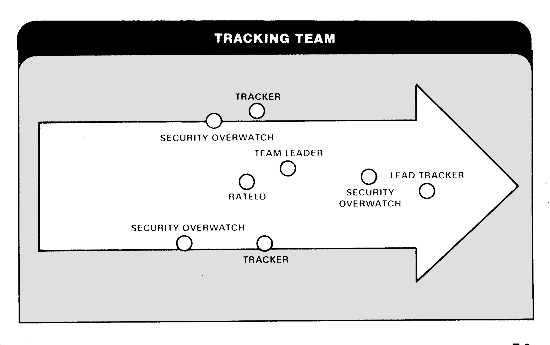
TRACKER DOGS
Tracker dogs may be used to help track an enemy. Tracker dogs are trained and
used by their handlers. A dog tracks human scent and the scent of disturbed
vegetation caused by man's passing.
Tracker dogs should be used with tracker teams. The team can track visually,
and the dog and handler can follow. If the team loses the signs, then the dog
can take over. A dog can track faster than a man tracks, and a dog can track at
night.
A tracker dog is trained not to bark and give away the team. It is also
trained to avoid baits, cover odors, and deodorants used to throw it off the
track.
COUNTERTRACKING
In addition to knowing how to track, you must know how to counter an enemy
tracker's efforts to track you. Some countertracking techniques are discussed in
the following paragraphs:
-
While moving from close terrain to open terrain, walk past a big tree (30
cm [12 in] in diameter or larger) toward the open area for three to five
paces. Then walk backward to the for-ward side of the tree and make a
90-degree change of direction, passing the tree on its forward side. Step
care-fully and leave as little sign as possible. If this is not the direction
that you want to go, change direction again about 50 meters away using the
same technique. The purpose of this is to draw the enemy tracker into the open
area where it is harder for him to track. That also exposes him and causes him
to search the wrong area.
-
When approaching a trail (about 100 meters from it), change your direction
of movement and approach it at a 45-degree angle. When arriving at the trail,
move along it for about 20 to 30 meters. Leave several signs of your presence.
Then walk backward along the trail to the point where you joined it. At that
point, cross the trail and leave no sign of your leaving it. Then move about
100 meters at an angle of 45 degrees, but this time on the other side of the
trail and in the reverse of your approach. When changing direction back to
your original line of march, the big tree technique can be used. The purpose
of this technique is to draw the enemy tracker along the easier trail. You
have, by changing direction before reaching the trail, indicated that the
trail is your new line of march.
-
To leave a false trail and to get an enemy tracker to look in the wrong
direction, walk backward over soft ground. Continue this deception for about
20 to 30 meters or until you are on hard ground. Use this technique when
leaving a stream. To further confuse the enemy tracker, use this technique
several times before actually leaving the stream.
-
When moving toward a stream, change direction about 100 meters before
reaching the stream and approach it at a 45-degree angle. Enter the stream and
proceed down it for at least 20 to 30 meters. Then move back upstream and
leave the stream in your initial direction. Changing direction before entering
the stream may con fuse the enemy tracker. When he enters the stream, he
should follow the false trail until the trail is lost. That will put him well
away from you.
-
When your direction of movement parallels a stream, use the stream to
deceive an enemy tracker. Some tactics that will help elude a tracker are as
follows:
-
Stay in the stream for 100 to 200 meters.
-
Stay in the center of the stream and in deep water.
-
Watch for rocks or roots near the banks that are not covered with moss
or vegetation and leave the stream at that point.
-
Walk out backward on soft ground.
-
Walk up a small, vegetation-covered tributary and exit from it.
-
When being tracked by an enemy tracker, the best bet is to either try to
outdistance him or to double back and ambush him.
